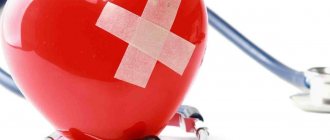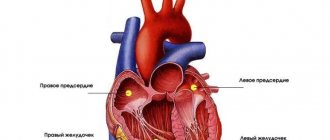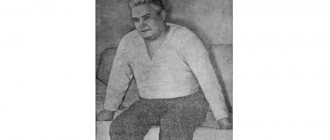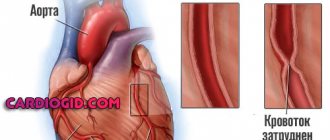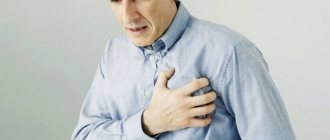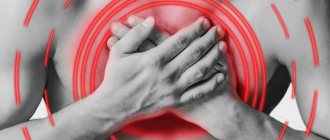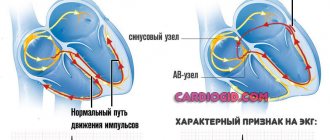If a woman has chest pain, this is a characteristic symptom of many processes, not necessarily of cardiac origin. There are a lot of pulmonary and gastroenterological diagnoses.
Differential diagnosis is carried out using instrumental methods. It is difficult to determine the origin of a trait on the spot; a number of characteristic features help to navigate.
The pain varies in intensity, typical moments (pressing, aching, stabbing, burning), based on minimal data on well-being, some conclusions can be drawn, but ECG, ECHO-CG and daily monitoring put an end to the issue.
It is not the pain syndrome itself that needs to be treated, but the root cause that brought it to life. The symptom is relieved with the help of Nitroglycerin, partly with phenobarbital preparations. The quality of the therapy depends on the accuracy of the examination.
Signs of heart disease in women do not differ specifically from discomfort in men. With the difference that representatives of the fairer sex suffer from vascular pathologies almost three times less often under equal conditions.
How to distinguish heart pain from others?
Discomfort in the chest is not always caused by pathologies of the muscular organ itself.
The syndrome caused by diseases of the cardiac structures is distinguished by a number of specific features:
- Character. The type of pain in the heart is often pressing, dull (they account for 90% of cases and complaints), and burning. It is extremely rare to prick, which already casts doubt on the diagnosis.
- Intensity. High strength occurs only during a heart attack and emergency conditions. In other situations, we are talking about average, but painful, long-term discomfort.
- The effectiveness of using Nitroglycerin is the first sign that the problem is in the heart. Pulmonary and other pains are not relieved by drugs of this kind.
- No increase or decrease in discomfort when changing body position.
- There is no reaction to palpation of the chest or back. Which is not typical for other pathologies.
- The depth of inspiration does not affect the symptom. This is an easy way to check where the source of the unpleasant sensation is.
These signs are taken into account, including by emergency doctors at the time of the initial examination.
Attention:
There are exceptions to every rule. Therefore, patients should not treat these provisions as dogmas. The final word belongs to the doctors.
Etiology
Pain or discomfort in the chest area is a reason to consult a doctor. This is especially true for patients at high risk of developing a heart attack or other forms of coronary heart disease (CHD).
Factors contributing to the occurrence of the corresponding symptom:
- atherosclerotic lesions of the coronary vessels;
- overweight (you can calculate your body mass index here);
- smoking;
- chronic inflammatory processes in the body (tonsillitis, sinusitis, etc.);
- diseases of the peripheral nervous system.
These factors are mechanisms that trigger the pathogenetic mechanism of pain development. Depending on the individual characteristics of each organism, different intensity of the symptom is observed.
Mechanisms of chest pain:
- ischemia – a discrepancy between the need for oxygen for the operation of the main “pump” in the human body and the volume of its supply;
- inflammatory process of bacterial, viral or fungal origin;
- traumatic injury;
- neurological problems.
Depending on the mechanism of origin of the unpleasant symptom, its nature and the complaints with which the patient presents will differ. The doctor needs to quickly understand the situation to confirm or exclude life-threatening diagnoses and choose the optimal method of treating the person.
For example, if a patient comes to see me and complains that he has pain in his heart radiating to his left arm, I consider him first of all as a potential candidate for myocardial infarction. First, I need to exclude this diagnosis, and only after that can I carry out further differentiation in a calmer manner.
Common diseases
The most dangerous and common cause of pain in the chest area with migration to the arm remains myocardial infarction. The pathology is a form of coronary heart disease and annually claims millions of lives across the planet.
Characteristic signs of pain during a heart attack that everyone should remember:
- pronounced intensity (in 80% of cases);
- pressing or burning sensation. Patients sometimes say that “an elephant stepped on their chest”;
- duration more than 30 minutes;
- numbness or irradiation (spread) to the left arm, shoulder blade, corresponding half of the neck or jaw.
Patients with similar clinical symptoms are always urgently referred for specific diagnostics (ECG, blood test for troponin I, Echo-CG, coronary angiography) to verify the infarction and carry out appropriate treatment.
In addition to a heart attack, chest pain is often a consequence of the following diseases:
- Stable, variant and unstable angina. The principle of development of symptoms is the same as during a heart attack, but without myocardial necrosis.
- Pericarditis. Due to inflammation of the outer lining of the heart against the background of a bacterial, viral or fungal infection, specific receptors are irritated, which leads to the appearance of the symptom.
- Thoracic radiculitis. In this case, the pain in the heart is localized to a small area and has a stabbing nature. Noteworthy is the numbness of the hands and fingers, which develops due to compression of the nerve endings that emerge from the holes in the corresponding part of the spine.
- Myocarditis. The pain is less pronounced. Numbness of the hands in this case is much less common.
- Vegetovascular dystonia (VSD) (for more information about this condition, see the video below). Patients with this diagnosis almost always complain of heart pain. The sign may be accompanied by migration to the arm, but the severity of clinical symptoms is inferior to ischemic heart disease.
Timely diagnosis of the cause of acute pain will improve the prognosis for the patient and prevent the development of complications such as heart failure, fatal arrhythmias and myocardial ruptures.
Localization of heart pain
The location of the discomfort depends little on the origin of the syndrome. However, there are several typical features that give rise to considerations.
- Against the background of noncardiac causes, the sensation is detected at a specific point. The patient can point with his finger where the source of discomfort is located. Heartache diffused, reflected.
- Localization - epigastric region. Leads the patient to a dangerous delusion. Cardiological diseases are not always accompanied by unbearable discomfort. If the location is the stomach area, the person is sure that he has gastritis. A heart attack is often masked in this way.
You need to look at the accompanying moments. Inflammation of the mucous membranes of the gastrointestinal tract does not cause shortness of breath, tachycardia, pallor of the skin, cyanosis of the nasolabial triangle, and other manifestations such as fatigue, weakness, drowsiness, dizziness - these are symptoms of heart problems.
- Localization - left side of the sternum. The cardiac origin of the pain is difficult to establish. Without other symptoms, with the positive signs mentioned above (increased breathing, etc.), extracardiac events are likely.
It is impossible to detect the exact factors without diagnostic measures. It is recommended to consult a doctor. If intense discomfort develops, call an ambulance.
Where does a woman's heart hurt?
Signs of heart disease do not have a clear connection with the location of the discomfort. But there are several typical features:
- extracardiac causes manifest themselves at a specific point, cardiac causes are spread throughout the chest and can radiate;
- a burning sensation in the stomach can have two causes: gastritis or myocardial infarction, the diagnosis in this case is based on accompanying symptoms;
- localization of pain in the left side of the chest most often indicates cardiac pathology.
In this case, they distinguish:
- localization typical for women, it is also called retrosternal (central) or left-sided. Stitching sensations in this case indicate extracardiac causes, but when the anterior surface of the chest at the level of the mammary glands is sensitive, and the pain is pressing, dull, the myocardium sends an SOS signal. Radiates to the left shoulder, arm, left side of the neck, shoulder joint;
- atypical localization, which is considered to be the location of unpleasant sensations in the right half of the chest, epigastric region, throat. Sometimes, when the organ is located on the right side (dextrocardia), everything changes in a mirror image.
It is especially important not to confuse metastatic manifestations of breast cancer and other causes of chest pain of different nature.
Dull, pressing pain
Occurs especially often. 90% of clinical cases are of this variety. Among the causes are almost always dangerous conditions, but not necessarily of urgent origin:
- Angina pectoris. Form of coronary insufficiency. It develops as a result of narrowing or blockage of the arteries that supply the muscular organ. The consequence is the death of cardiomyocytes, which is precisely accompanied by a pain syndrome of moderate intensity.
Its duration varies from a couple of minutes to half an hour. Very rarely anymore. This is the basis for revising the probable diagnosis towards a heart attack.
An additional symptom of a heart problem in a woman is shortness of breath. Occurs as a result of gas exchange disturbances.
Angina pectoris occurs in attacks, their frequency varies and depends on the form of the disease (rest, stress) and the provoking factor. Treatment in a hospital, with the use of protectors, antihypertensive, antiarrhythmic, and other drugs.
- Development of aortic aneurysm. Protrusion of the vascular wall is fraught with its rupture and bleeding. In the case of the largest artery of the body, this is especially dangerous. Pressing pain appears sporadically, for a few minutes.
An aneurysm is discovered by chance. Treatment is carried out immediately, using surgical methods, taking into account possible contraindications. If a woman is pregnant, surgery may be postponed for a while.
- Myocarditis. Inflammation of the heart muscle. The pain is severe and constant. The feeling of pressure in the chest alternates with a burning sensation. It is not difficult to detect pathology; additional symptoms are specific. This is stable, constant tachycardia even at night, shortness of breath, increased body temperature, pale skin and cyanosis.
Urgent treatment in the cardiology department. Constant monitoring of the patient's condition is necessary. Delay ends in sclerosis - scarring of heart tissue. Destruction of the muscle layer is the path to coronary artery disease, heart failure and further possible death.
- Pericarditis. Inflammation of the bursa containing the muscular organ. It prevents structures from moving relative to their normal anatomical position and keeps the heart in one place, mechanically stabilizing it.
Pericarditis is of infectious or autoimmune origin. Lack of therapy ends with the release of transudate into the cavity of the bag. Next, compression develops, tamponade of the organ, its arrest and death of the patient.
- Stenosis of the aortic, tricuspid, mitral valves. All conditions are considered heart defects. Congenital or, more often, acquired. Accompanied by hemodynamic disturbances, the creation of excess pressure in the chambers of the muscular organ, myocardial growth, thickening and/or expansion (dilatation).
Surgical restoration is effective only in the early stages. In some cases, pain is the only symptom. Shortness of breath and disturbances of consciousness occur later, after the situation worsens.
General symptoms
Failures in cardiac activity can give rise to a variety of clinical symptoms. Let's look at it in more detail:
- First manifestations. At an early stage, heart problems in men are manifested by the following symptoms:
- unreasonable feelings of anxiety;
- decreased appetite;
- too frequent or rare pulse;
- high blood pressure;
- frequent coughing (expectorants do not help);
- problems with erection.
- Heaviness and feeling of constriction in the chest. This is a very common symptom that is always present with angina. Heaviness and squeezing sensations in the chest can occur both during physical effort and at rest.
- Cold. When a person is exposed to cold air (an open window in cold weather, going outside in windy weather), pain occurs in the chest due to a sharp spasm of the coronary vessels. This is typical for weather-dependent people. Often such an attack is also accompanied by a fear of death.
- Snoring during sleep, apnea. Snoring and short-term cessation of breathing during sleep are often evidence of heart disease in men.
- Shortness of breath and fatigue. Shortness of breath is manifested by a feeling of lack of air or slight suffocation. The modern rhythm of life implies the constant use of personal vehicles and elevators. There are not many opportunities left for physical activity. If a person decides to climb the stairs and develops shortness of breath on the 2nd or 3rd floor, then this is an alarming sign.
Also, you should be wary of rapid fatigue after walking or doing homework. This means that due to physical inactivity, the cardiovascular system has weakened and coronary insufficiency has appeared.
- Nausea and gastralgia. Often, disruptions in cardiac activity manifest themselves in the form of discomfort in the epigastric region and nausea. This happens due to the high position of the diaphragm, which is adjacent to the heart. Without knowing this, people may confuse this condition with simple indigestion.
- Edema. Every minute the heart pumps a large amount of blood. If it cannot fully perform its function, then the latter stagnates in the lower extremities.
Edema occurs due to the leakage of the liquid part of the blood from the vessels into the tissues. Most often, the feet and hands swell. At an early stage, they can be identified by the fact that the usual shoes begin to pinch, and marks from socks remain on the feet. Even if the swelling is not pronounced, it still indicates a serious disruption of blood flow. At first they usually bother you from time to time, mainly in the evenings, but over time they persist throughout the day.
- Headache. A characteristic symptom is persistent pain in the temporal and occipital regions, which does not go away even after using analgesics. They usually appear in the morning.
- Arthralgia. Another symptom is pain in the wrist or elbow. They can occur after exercise and spread to the entire arm.
- Urge to go to the toilet at night. Frequent and unbearable urge to urinate at night can warn of problems with the heart. In a horizontal position, all fluid from distant parts of the body flows upward. Accordingly, blood flow to the heart increases and the heart muscle works harder. The already processed fluid is sent to the bladder.
- Chest pain. Pain impulses are formed due to the fact that the heart muscle does not receive all the nutrients it needs. At first, the pain may be short-term and go away on its own. Over time, they become regular. They can be divided into two types:
- Typical. Pain is noted behind the sternum with radiation to the lower jaw, neck, collarbone and upper limb.
- Atypical. When describing complaints, a man primarily focuses on areas of irradiation (on the right side of the sternum, under the ribs, in the stomach area).
Burning discomfort
Complaints of a feeling of increased temperature in the chest are less common, but this is a dangerous sign of heart disease in women and often indicates emergency conditions:
- Heart attack. Acute necrosis of cardiac structures as a result of ischemia. It is considered a variant of coronary insufficiency. A symptom of heart problems is intense, unbearable chest pain. It radiates to the arm, shoulder blade, neck, stomach.
Attention:
In 15% of cases, the strength of the manifestation is moderate, this is even more dangerous, since the patient confidently goes towards death, without even knowing it.
A heart attack requires urgent hospitalization. Further, everything depends on the moment of starting therapy. With extensive damage, the chances of survival drop sharply.
They use drugs to normalize blood pressure, antiarrhythmics and others as appropriate. The list is wide. The prognosis is relatively unfavorable. Relapses will most likely result in death.
- Ruptured aortic aneurysm. Violation of the integrity of the wall of the vascular formation. Leads to massive bleeding. Usually the aorta is affected, death occurs in a matter of minutes.
Localization of pain - neck, throat, chest. Within seconds, the symptoms of syncope increase, and the patient loses consciousness. First aid is ineffective, as is treatment. Doctors and others do not have time to react.
What do men need to know about heart disease?
Typically, men notice problems with their health only when the body literally begins to “cry for help.” Take your blood pressure right away and run to the doctor, do you have a slight ache in your chest? Well, no, this is not at all “manly.”
Meanwhile, according to statistics, it is men who are at greater risk when it comes to cardiovascular diseases. In this respect they are the weaker sex. If you ignore the “first warning signs,” the consequences can be dire. After all, heart and vascular diseases are in first place among the causes of disability and mortality in the modern world.
Cardiovascular pathologies in men in facts and figures:
- According to the American Heart Association, more than one in three adult men has cardiovascular disease.
- 48% of deaths from heart disease occur among men.
- In Russia, the mortality rate from these pathologies is approximately twice as high as in developed countries.
- Men have higher risks than women.
- Before the age of 70-75, men are three times more likely than women to die from coronary heart disease, and from strokes - 30% more often.
- Risks vary greatly depending on lifestyle and diet. Everyone can reduce them.
Tingling, shooting
They are extremely rare in cardiac pathologies. But this is also possible.
Causes:
- Neurogenic sensations. The so-called cardialgia of psychosomatic origin. Occurs against a background of stress and emotional stress.
Not accompanied by other symptoms of cardiac origin. Possible sweating, shortness of breath (false), tinnitus, and lightheadedness.
Neurogenic pain is not dangerous. Therefore, treatment as such is not necessary. But it will not be possible to diagnose such a form at once. The diagnosis is made by exclusion.
- VSD or vegetative-vascular dystonia.
Theoretically, all of the conditions presented above can provoke shooting pains, but such discomfort accounts for about 2.5% of situations.
Extracardiac factors
More numerous:
- Pneumonia. It is provoked by so-called pneumococci, less often by pyogenic flora. Gives severe chest pain on one or both sides, painful shortness of breath, turning into attacks of asphyxia in the supine position. Treatment with antibiotics early to prevent chronicity.
It is not difficult to limit the pain syndrome: when inhaling, the discomfort intensifies, whistling and wheezing occur. Breathing is hard. This does not happen against the background of cardiac conditions.
- Bronchitis. Accompanied by approximately identical symptoms, sometimes more pronounced. Differential diagnosis is carried out with pneumonia.
- Stomach ulcer. Violation of the integrity of the mucous membrane of the organ, formation of erosion, thinning of the epithelial layer in the affected area.
The pain syndrome is located in the epigastric region; it is impossible to determine exactly where; reflected sensations in the chest are possible. They are falsely taken to be cordial.
Attention:
An ulcer is the first thing to differentiate from cardiological diseases.
- Gastritis. Inflammation of the gastric mucosa. Gives the same symptoms. States are determined by specific moments. Such as flatulence, nausea, vomiting, heartburn and belching (dyspepsia). Loose stools and constipation are also possible. Cardiovascular pathologies are not accompanied by gastrointestinal symptoms.
- Esophageal hernia. Expansion of the hollow structure at the level of its confluence with the stomach. Accompanied by pain in the chest of unclear localization. Pressing, dull. Intensified by eating. Delineation using FGDS. Treatment is surgical. The operation is aimed at restoring normal anatomy.
- Osteocondritis of the spine. Mainly the thoracic region. The discomfort is constant and intensifies with physical activity, lifting heavy objects, and moving the arms (especially holding them above the head).
These features can be used for differential diagnosis purposes. The progression of the pathology leads to rupture of the fibrous membrane of the intervertebral disc and prolapse of the nucleus pulposus. A hernia forms. When the surrounding nerve endings are compressed, the pain becomes much stronger.
Specific signs are numbness of the fingers, a feeling of pins and needles, a drop in muscle tone, weakness below the level of the lesion, paresis, and rarely, paralysis. There are no cardiac symptoms, which makes delimitation a matter of time.
- Intercostal neuralgia. Inflammation of muscle fibers and nerve endings. It is often mistaken for a symptom of heart disease. The pain is pronounced, intense, unbearable. Dagger. But there is no danger. Treatment with anti-inflammatory drugs.
If a woman has heart pain during pregnancy, the reason is functional. Hormonal imbalance, vascular stenosis of the muscular organ. There are many options.
Therefore, expectant mothers with identified problems or a tendency to such problems are regularly seen by a cardiologist every 1-3 months. Pain in the sternum requires increased attention. In case of suspicion, it is recommended to call an ambulance.
Causes not related to heart disease
Heart pain in men is not necessarily associated with cardiac pathology. There are other reasons, including:
- Lung diseases. Pleurisy occurs with acute pain, aggravated by inhalation and coughing. Pneumonia is also sometimes accompanied by pain similar to heart pain.
- Pathologies of the gastrointestinal tract. Pain with such problems will be longer lasting and depend on food intake. Most often they are accompanied by heartburn, vomiting, and nausea. The symptoms of acute pancreatitis are similar to myocardial infarction - severe pain, nausea and vomiting.
- Diseases of the central nervous system. The pain is short-term or constant, sharp or aching. Neuroses are accompanied by various autonomic disorders: anxiety, irritability, headaches, sleep disturbances. As a rule, such patients describe their complaints extremely emotionally.
- Cervical and thoracic osteochondrosis. The clinical picture is similar to angina pectoris. A person experiences pain in the cardiac region (intensifies with movement and breathing), and the upper limbs may become numb. You can distinguish osteochondrosis from angina pectoris using nitroglycerin. In case of problems with the spine, it does not help.
- Intercostal neuralgia. Sharp and stabbing pains that intensify with sneezing, coughing, sudden movements and breathing. They are localized pointwise, and a sick man can always clearly show where he hurts. With angina, patients usually point to a large area.
Even in case of successful relief of heart pain, a man needs to seek help from a doctor and undergo all the necessary examinations. Otherwise, you can develop a dangerous disease, which can lead to serious health consequences.
Urgent help at home
The main problem is the lack of understanding of what actually hurts and why. For this reason, you need to act extremely delicately. The first measure is to call an ambulance team. Doctors should figure it out.
Before arrival, the algorithm is as follows:
- Open a window or window. Provide a flow of fresh air to enrich the blood with oxygen.
- If shortness of breath or heart rhythm disturbances develop, loosen the collar of your clothing and remove body jewelry. Compression of the carotid sinus and trachea will lead to a reflex disturbance of cardiac activity. Dangerous complications are possible.
- Take a Nitroglycerin tablet. One. For heart pain this should work. If the effect is ineffective or partial, you can take more after 10-20 minutes. No more than 2 pieces in total.
- Breath control is not needed.
What you should never do
Take medications on your own. It is not known what caused the pathological condition. You can only make things worse with your own illiterate actions.
- Engage in physical activity. A heart attack and other phenomena will provoke cardiac arrest. It's better to sit and wait.
- Wash with cold water. Reflex narrowing of facial vessels can result in asystole, fainting and death. Especially in the hot season.
- Use folk remedies. They are divided into two groups. The first ones are completely useless, therefore they are not worth the time and effort. The latter require precise dosing and a clear application regimen, which is difficult to find in open sources. This is, for example, tincture of chokeberry and elderberry. If used incorrectly, it will cause a sharp drop in blood pressure with all the typical consequences. It’s better to put grandma’s book on traditional treatment on the shelf.
- Eating. Possible loss of consciousness. In a faint, a person has no control over the state of things. Reflex vomiting is possible. This is the brain’s response to lack of trophism and tissue damage. Aspiration of stomach contents is almost guaranteed to result in death.
When doctors arrive, you should tell them how you are feeling. It is short and to the point and is in the best interest of the patient. Next, the question is decided: to help on the spot or transport to a hospital.
There is no need to refuse hospitalization. If everything is in order, the person will be released the next day. If pathologies are detected, there is no need to explain the meaning. Everything is clear and so.
When to call an ambulance
In any doubtful case. There is no point in being shy; dispatchers rank situations in order of priority.
Therefore, they talk about the condition as it is, without exaggerating, but nothing can be hidden, otherwise you can wait for an ambulance for several hours.
An approximate list of symptoms that you should pay close attention to:
- Extremely intense chest pain. Regardless of the duration of manifestation. A heart attack may develop.
- Discomfort is moderate, but long-lasting. More than 30 minutes.
- Dyspnea. Inability to get air, dissatisfaction with the process. Especially if the symptom worsens when lying down.
- Weakness, drowsiness, apathy, inability to do anything even in everyday life.
- Paleness of the skin and mucous membranes.
- Cyanosis (blue discoloration) of the nasolabial triangle.
- Impaired consciousness such as fainting. Especially if the manifestation occurs repeatedly.
- Tachycardia, or decreased heart rate. Other sensations: freezing in the chest, strong pressure, distension, passing blows.
Each symptom presented separately is a symptom of heart disease. If the condition develops over a long period of time, it is necessary to find the opportunity to consult a cardiologist.
Oddly enough, with a stable course of pathologies, menstrual irregularities are likely.
